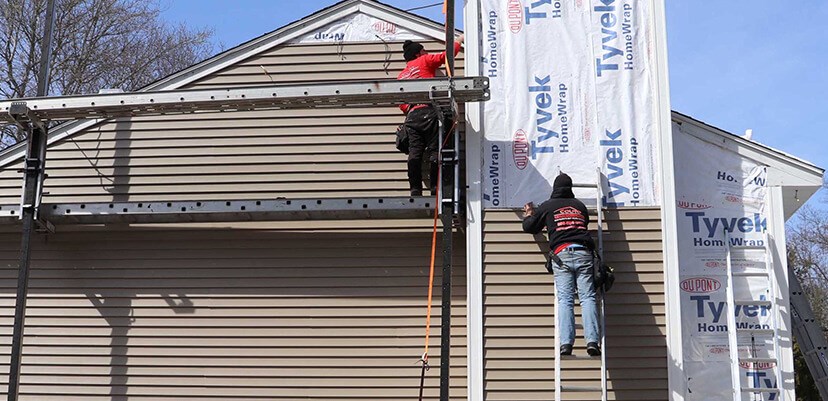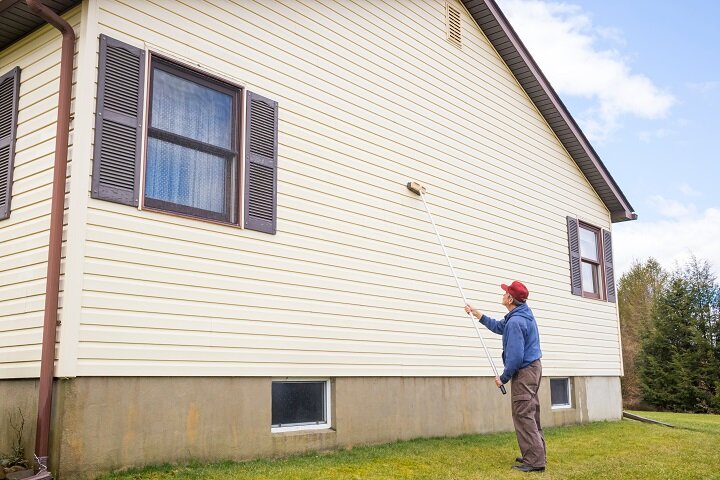Morris Siding Contractor Providing Energy-Efficient Home Exterior Installations
Morris Siding Contractor Providing Energy-Efficient Home Exterior Installations
Blog Article
The Necessary Guide to the Various Kinds Of Siding and Their Special Advantages
In the realm of home renovation, selecting the best home siding is a critical decision that affects both aesthetic charm and practical efficiency. With so lots of options to take into consideration, which house siding material really stands out for your specific task?
Wood House Siding
Wood house siding, a preferred choice for residential outsides, uses a timeless visual that combines all-natural elegance with structural stability. This home siding material is available in different designs, including clapboard, shingles, and board-and-batten, enabling homeowners to customize their appearance to match their layout preferences. Timber home siding is typically crafted from long lasting species such as cedar, redwood, or want, which are known for their resilience and ability to hold up against environmental stressors.
One of the main benefits of wood home siding is its exceptional insulation properties, which can add to energy performance and reduced home heating expenses. Additionally, wood home siding is eco-friendly, making it an eco friendly alternative when sourced sustainably. Routine maintenance, consisting of paint or staining, can lengthen its life-span and enhance its look, allowing house owners to protect the natural appeal of the wood.
Nonetheless, prospective disadvantages consist of vulnerability to parasites, rot, and weather condition damages, requiring sufficient treatment and upkeep - morris siding contractor. Despite these problems, when effectively cared for, timber home siding can offer a durable and lovely service that enhances the character of a home while supplying a cozy, welcoming environment

Vinyl Exterior Siding
Plastic exterior siding has become a leading selection for homeowners seeking a low-maintenance outside alternative that combines sturdiness and affordability. This versatile product is crafted from polyvinyl chloride (PVC), making it resistant to different weather problems, including dampness and UV rays. Consequently, plastic exterior siding does not warp, rot, or discolor, ensuring lasting visual charm.
Among the main advantages of vinyl home siding is its extensive variety of designs and shades, enabling home owners to achieve the desired seek their home without the demand for frequent repainting. Furthermore, plastic exterior siding is simple to mount, which can considerably minimize labor prices during building or restoration tasks.
Vinyl home siding additionally contributes to energy effectiveness. Many options function insulation backing, which improves thermal efficiency, helping to preserve comfy indoor temperature levels and possibly lowering power expenses. Its smooth surface area assists in easy cleansing, calling for only regular cleaning with a garden hose pipe to get rid of dirt and debris.
Fiber Concrete Home Siding
Fiber concrete exterior siding has actually obtained traction among contractors and home owners alike because of its impressive mix of toughness and aesthetic flexibility. Made up of a mixture of cellulose, concrete, and sand fibers, this home siding option is crafted to endure severe climate condition, including high winds, heavy rainfall, and temperature fluctuations, making it a durable option for domestic More hints exteriors.

One of the visit key advantages of fiber concrete siding is its resistance to pests, such as termites, and its non-combustible nature, offering boosted fire security. morris siding contractor. Additionally, it is readily available in a large range of textures, colors, and styles, enabling house owners to attain their desired visual without giving up performance
One more benefit is its reduced maintenance demands; fiber concrete siding normally requires painting or discoloration every 5-10 years, which is much less constant than other products. Its long life adds to a lower total price of ownership, as it decreases the demand for frequent repair work or replacements.
Inevitably, fiber concrete siding represents an exceptional financial investment for those seeking a resilient, eye-catching, and functional exterior option, integrating both type and function to enhance the home's aesthetic charm.
Metal Exterior Siding
The allure of metal home siding depends on its robust sturdiness and modern aesthetic charm, making it a preferred option for contemporary architecture. Readily available in products such as light weight aluminum and steel, metal exterior siding provides a range of finishes and colors, permitting home owners to accomplish a tailored appearance that enhances their read the article layout vision.

Power effectiveness is an additional substantial advantage, as many metal exterior siding products are made with insulation options that aid control interior temperature levels. This can bring about lowered power prices with time. In addition, steel siding is typically recyclable, making it an ecologically friendly selection for sustainability-minded home owners.
The installation process for metal home siding can be relatively straightforward, leading to a quicker turnaround time for building and construction projects. Generally, steel home siding combines capability and style, making it a useful choice for those seeking a aesthetically enticing and enduring exterior coating.
Brick and Stone House Siding
Brick and rock exterior siding sticks out as a timeless choice that improves the visual beauty of any kind of home. Known for their durability and low maintenance, these materials provide a remarkable roi while raising the residential property's aesthetic appeal. Offered in different colors, structures, and patterns, block and stone can be tailored to suit varied architectural designs, from typical to modern.
Among the main advantages of brick and rock home siding is their energy performance. Both materials possess natural insulating homes that help regulate indoor temperature levels, potentially reducing cooling and heating prices. Furthermore, they provide superior fire resistance compared to other home siding options, adding to boosted safety and security.
An additional benefit is their longevity. Brick and rock can last for decades, typically calling for marginal upkeep beyond occasional cleaning. Unlike wood house siding, they are impervious to insects and rot, making sure a long-lasting exterior that endures the aspects.
Final Thought
In summary, the option of house siding significantly impacts a home's visual allure, power performance, and maintenance requirements. Each type of exterior siding-- whether wood, vinyl, fiber steel, block, or cement and stone-- provides unique advantages customized to various homeowner preferences and environmental conditions.
One of the key advantages of wood house siding is its superb insulation properties, which can add to power effectiveness and lower home heating expenses. Additionally, timber siding is naturally degradable, making it an ecologically friendly alternative when sourced sustainably.One of the key advantages of metal exterior siding is its resistance to numerous ecological factors.Power efficiency is another significant benefit, as numerous metal siding products are created with insulation alternatives that help manage indoor temperatures. Each kind of exterior siding-- whether wood, vinyl, fiber steel, block, or concrete and stone-- uses one-of-a-kind benefits tailored to various house owner choices and ecological problems.
Report this page